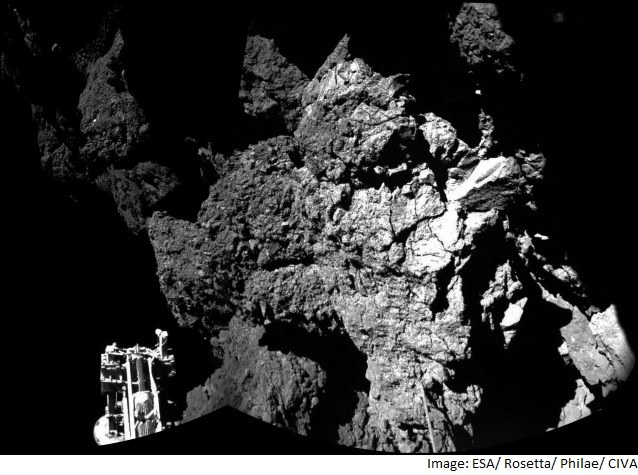- Home
- Science
- Science News
- Philae Lander Finds Organic Material, Points to Microbial Life on Comet
Philae Lander Finds Organic Material, Points to Microbial Life on Comet

The organic-rich black crust of the comet named 67P/Churyumov-Gerasimenko was likely caused by microorganisms living beneath an icy surface, The Guardian reported citing leading astronomers.
"These are not easily explained in terms of prebiotic chemistry. The dark material is being constantly replenished as it is boiled off by heat from the sun. Something must be doing that at a fairly prolific rate," astronomer and astrobiologist Chandra Wickramasinghe, who was involved in the mission planning of Philae 15 years ago, was quoted as saying.
(Also see: Rosetta Spacecraft Finds Massive Sinkholes on Comet's Surface)
He said that people should be more open to the possibility of alien life. The data coming from the comet seems to point to "micro-organisms being involved in the formation of the icy structures, the preponderance of aromatic hydrocarbons, and the very dark surface", he added.
Rosetta, the ESA spacecraft orbiting the comet, is also said to have picked up strange clusters of organic material that resemble viral particles.
The European Space Agency successfully landed Philae on the comet in November. Since then, the lander has undergone a period of hibernation from which it awoke in June after its solar panels were recharged. Neither Rosetta nor Philae are equipped to search for direct evidence of life.
Wickramasinghe and colleague Max Wallis, from the University of Cardiff, believe 67P and other such comets could be homes for microbes similar to the "extremophiles" that inhabit the most inhospitable regions of the Earth, the daily reported.
For the latest tech news and reviews, follow Gadgets 360 on X, Facebook, WhatsApp, Threads and Google News. For the latest videos on gadgets and tech, subscribe to our YouTube channel. If you want to know everything about top influencers, follow our in-house Who'sThat360 on Instagram and YouTube.
Related Stories
- Samsung Galaxy Unpacked 2025
- ChatGPT
- Redmi Note 14 Pro+
- iPhone 16
- Apple Vision Pro
- Oneplus 12
- OnePlus Nord CE 3 Lite 5G
- iPhone 13
- Xiaomi 14 Pro
- Oppo Find N3
- Tecno Spark Go (2023)
- Realme V30
- Best Phones Under 25000
- Samsung Galaxy S24 Series
- Cryptocurrency
- iQoo 12
- Samsung Galaxy S24 Ultra
- Giottus
- Samsung Galaxy Z Flip 5
- Apple 'Scary Fast'
- Housefull 5
- GoPro Hero 12 Black Review
- Invincible Season 2
- JioGlass
- HD Ready TV
- Laptop Under 50000
- Smartwatch Under 10000
- Latest Mobile Phones
- Compare Phones
- Moto G15 Power
- Moto G15
- Realme 14x 5G
- Poco M7 Pro 5G
- Poco C75 5G
- Vivo Y300 (China)
- HMD Arc
- Lava Blaze Duo 5G
- Asus Zenbook S 14
- MacBook Pro 16-inch (M4 Max, 2024)
- Honor Pad V9
- Tecno Megapad 11
- Redmi Watch 5
- Huawei Watch Ultimate Design
- Sony 65 Inches Ultra HD (4K) LED Smart TV (KD-65X74L)
- TCL 55 Inches Ultra HD (4K) LED Smart TV (55C61B)
- Sony PlayStation 5 Pro
- Sony PlayStation 5 Slim Digital Edition
- Blue Star 1.5 Ton 3 Star Inverter Split AC (IC318DNUHC)
- Blue Star 1.5 Ton 3 Star Inverter Split AC (IA318VKU)

















